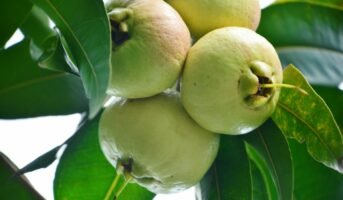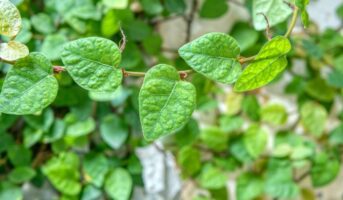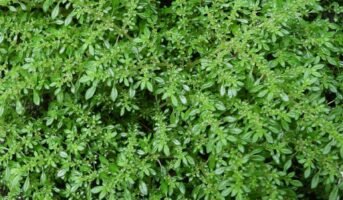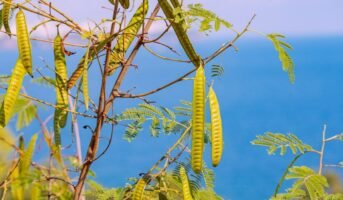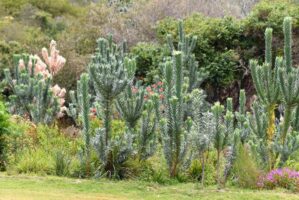Saccharum Spontaneum (Kans) is the name of a native grass of the Indian Subcontinent. In Nepal, kans grasses are harvested and utilised to enclose vegetable plots or rooftop activities. It is also known as Wild Sugarcane, Kans Grass, Fodder Cane, African Fodder Cane, and Asian Fodder Cane.
Its capacity to swiftly assimilate disturbed soil elsewhere has allowed it to develop into an invasive species that encroaches on croplands and pasturelands, as noted in the concerned region.
In India, adult plants bloom by the end of the wet season, sprouting and appearing in June or July after the first showers of the wet season. Rhizomes are frequently used for vegetative propagation, resulting in significant seed production.
Saccharum Spontaneum: Quick facts
| Botanical name | Saccharum spontaneum |
| Type | Invasive; Weed of sugarcane, cotton, rice, tea, coffee, horticultural gardens |
| Leaf Type | Perennial grass with Slender Culms |
| Flower | Spikes of florets with silky and long white hairs |
| Varieties available | Three distinct biotypes: Hygrophilous, Xerophilous, and an intermediate type |
| Also known as | Wild Sugarcane; Kash in Bengali, Kasatandi in Odia, and Kohuwa in Assamese |
| Height | Upto 4 metres |
| Season | June and July, after the first monsoon showers |
| Sun Exposure | Full Sun |
| Ideal Temperature | 22-34°C |
| Soil Type | Wide range of soil types: alluvial, sandy, infertile, and saline soils. |
| Basic requirements | Little watering and pruning |
| Ideal Location for placement | Flowerbed borders, General, Coastal, Riverine, Beach shoreline, Hedge Screening |
| Ideal season to grow | Tropical, Monsoonal, Temperate, Mediterranean, Arid |
| Maintenance | Very Low |
See also: What is Hibiscus and how to grow it in your home?
Saccharum spontaneum: Physical Description

Source: Pinterest
It belongs to the grass family and grows up to three metres tall. Its perennial herb roots spread outward. In the Terai-Duar savanna and grasslands, a low-lying depositional environment at the foot of the Himalaya range in Nepal, India, Bangladesh, and Bhutan, kans grass quickly takes over exposure silt grasslands created annually by the receding monsoon floods, beginning to form nearly sheer did stand on the smallest segments of the flood zone.
The grasslands of kans are an essential habitat for Indian rhinoceros. A lot of parasites are also harboured here that spread to surrounding crops. S. spontaneum is a vital weed of cotton, pearl millet, maise, sugarcane, rice, fodder crops, horticulture gardens, and plantation crops, including tea and coffee in tropical and subtropical areas. In India, after the first monsoon rains, seeds begin to germinate and emerge in June or July.
Adult plants then start to produce flowers before the end of the yearly precipitation. The ability of this species to reproduce is poorly understood. It produces many seeds and is often cultivated vegetatively via rhizomes.
see also: all about Arum plant
Saccharum spontaneum: Growth
The concerned grass generally grows in the fields, not in the garden. But still, this plant may reach heights of up to 5 metres, and it can reproduce both vegetatively (from a vast network of rhizomes) and asexually (by dispersing thousands of seeds into the wind).
- spontaneum seems to have the capacity to seriously encroach on arable land, frequently leading to its abandonment. It has been demonstrated that it decreases the efficiency of various horticultural crops, including, for instance, sugarcane, latex, tea, grain, and tea.
Consequently, S. spontaneum is a host to various pests and diseases, which may act as a reservoir for transmitting these pests and diseases to nearby crops.
Saccharum Spontaneum: Maintenance
Hardy and quickly growing, it tolerates drought but prefers a lot of precipitation, resists various soil conditions, including alluvial, infertile, sandy, and salty soils, and accepts extensive grazing. To preserve leaf condition, routinely prune and divide seeds or rhizomes to multiply.
According to reports, numerous horticulture crops’ profitability has diminished due to this species’ invasion. In addition, several pests that propagate to the nearby farmland are hosted here. Saccharum spontaneum causes substantial harm to various crops in tropical and subtropical climates, including cotton, pearl millet, sorghum, sugarcane, rice, fodder crops, horticultural gardens, and crops like coffee and tea.
Saccharum Spontaneum: Uses
Ayurvedic texts from ancient India also refer to it as a herb. It helps improve the quality of breast milk in breastfeeding women and is used to treat menorrhagia, bleeding piles, painful urination, and renal calculi.
The plant’s stem appears a little firm, yet the leaves are pretty thin and have blunt edges. Saccharum spontaneum may be introduced into Mediterranean agricultural production to provide lignocellulose feedstock for second-generation industrial facilities or bio-refineries due to its high biomass yield and diversity of structural macromolecules.
See also: Garden roses: Facts and tips to grow
Saccharum Spontaneum: What are the benefits?
Strong and elastic fibre is obtained from kans grass. It is widely used in mats, bundles, harnesses, and braided rope production. The papermaking capability of kans grass is investigated by examining its fibre form and nearby lab testing. To create bleached papermaking pulp, soda pulping, conventional bleaching, and ECF bleaching were optimised.
- Due to rising prices, the rapid destruction of forest resources, and the effects on ecological integrity, raw materials from forests, such as bamboo grass, have become a subject of concern.
- Due to its affordability and greater fibre output, using quick-growing wood species to increase the supply of wood for the growth of the pulp and paper industry is a smart idea.
- In the meantime, the paper and pulp industry has started using substitute non-wood fibres to make different grades of paper globally.
- The concerned plant is also considered to be used in India’s ayurvedic practices. Compared to noble canes, Saccharum spontaneum has lower stalk sucrose, greater fibre, narrower stalks, and adequate blooming and tillering frequency to be considered a highly invasive species.
- Saccharum spontaneum is primarily responsible for sucrose buildup and the vigorous development of thick stalks in economic canes.
Saccharum Spontaneum: Problems
- spontaneum can seriously encroach on arable land, frequently leading to its abandonment. It has been demonstrated that it decreases the efficiency of various agronomic traits, including, for instance, sugarcane, rubber, tea, wheat, and tea.
Additionally, S. spontaneum is a host to various pests and diseases, which may act as a reservoir for transmitting these pests and diseases to nearby crops.
Saccharum spontaneum, an invading species that prevents regrowth in disturbing parts of the Panama Canal Watershed, has been targeted for control, and reforestation has been proposed as a method (PCW). Saccharum spontaneum disrupts the forest environment by encouraging fire, and this vegetation prevents natural regrowth.
FAQs
What is the common name of Saccharum spontaneum?
The common name of Saccharum spontaneum is kans grass.
How do you control the spread of Saccharum spontaneum?
Saccharum spontaneum, an exotic grass that prevents regrowth in disturbed parts of the Panama Canal Watershed, has been targeted for control, and reforestation has been proposed as a method.
What is the Kash flower called in English?
The Kash flower is also known as Saccharum spontaneum or kans grass.
Housing News Desk is the news desk of leading online real estate portal, Housing.com. Housing News Desk focuses on a variety of topics such as real estate laws, taxes, current news, property trends, home loans, rentals, décor, green homes, home improvement, etc. The main objective of the news desk, is to cover the real estate sector from the perspective of providing information that is useful to the end-user.
Facebook: https://www.facebook.com/housing.com/
Twitter: https://twitter.com/Housing
Email: [email protected]

